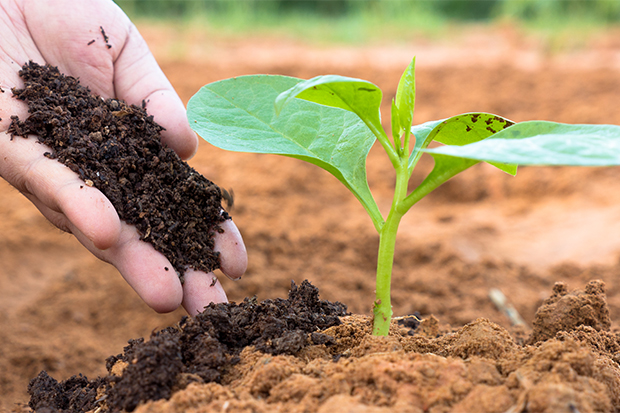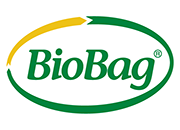The Role of Bioplastic in a Circular Economy
Posted on December 15, 2020 at 1:29 pm

BioBags are composed of, among other things, Mater-Bi, a compostable raw material produced by the Italian research company, Novamont. For more than 20 years, Novamont has produced environmentally friendly alternatives to polyethylene-based plastic bags and wrappers. Here is our take on the role of bioplastic in a circular economy.
Mater-Bi biodegradable plastic was developed to shift organic waste away from waste disposal sites and incinerators and towards biological decomposition, thereby producing compost to improve the soil. We all know that soil needs nutrients in order to remain fertile but did you know that soil is a limited resource? It is expected that the amount of cultivable soil per capita in the world will be halved by the time we reach 2050 due to development, erosion, and deforestation.
Novamont is a global leader in the field of bioeconomies and Catia Bastioli, CEO, is a pioneer in the development of production processes and products that can help decarbonise the economy – i.e. reduce CO2 emissions. “We don’t simply produce products. Everyone agrees it’s great to produce sustainable products. But we also need to be aware of the economic mindset we wish to aim for. In addition to products there must also be an interest in quality of life for people,” Catia Bastioli explains.
What is a circular economy?
Circular economies move us away from the linear Take-Make-Waste extractive model and towards an environmentally friendly economy in which production and consumption occur in a closed circle. In a circular economy, materials must be renewable and it is essential to avoid waste and wastage by designing materials, products and business models that are based on reuse.
In a biological circular economy, food waste and other organic materials are broken down into compost that can be used for soil enrichment. Composting is a decomposition process that generates carbon dioxide, which is far less harmful in relation to global heating than methane gas. In addition to carbon dioxide, compost contains other nutrients that can enrich and elevate soil quality. By using compost to grow foodstuffs we can limit the use of artificial fertilisers and irrigation.
We depend on healthy soil
“Soil is not renewable and it takes more than 2000 years to form a 10 cm layer of soil. But our lives depend on the soil – all production of food begins in the soil and soil binds enormous quantities of CO2 that would otherwise be released into the atmosphere. But in spite of this, the UN’s Food and Agriculture Organisation assesses that 33% of the planet’s soil is degraded and damaged by chemical contamination, acidification, nutrient imbalance and more,” says Novamont CEO, Catia Bastioli.
“If everyone knew that soil fertility, which is the basis of our food supply, was not renewable it would be a lot easier to create a sense of individual and collective responsibility.”
“The combined effects of climate change and an exhausted soil can, over the course of the next 30 years, reduce agricultural output by half in some drought-affected regions. Globally, we need much more organic material and a comprehensive separation of food waste and organic materials can help contribute to that,” says Catia Bastioli.
How BioBags can contribute to a circular economy
Sustainable products that are biodegradable, for example, compostable bioplastic, can help avoid an accumulation of non-natural and non-degradable contamination in the environment, traditional plastics, for example. Thereby achieving improved soil and water quality that can enrich the ecosystem. Soil and water retain their quality and become an integrated part of rebuilding and production. Bioproducts are not the ultimate solution to pollution but they can help limit it.
When municipalities use traditional plastic bags for collection of food waste, the remnants from the bags will contaminate agricultural land and, year after year, this plastic will accumulate and make our agricultural soil poorer over time. A compostable BioBag will, in contrast, decompose in the soil and become water, CO2 and humus.
Only two percent of the entire world’s consumption of plastic is reused for the same purpose and only 12 % is downcycled, i.e. it is reused but in a product of poorer quality than the original. Production and consumption must be circular so that we use the fewest resources possible, use those resources sensibly and then ensure that they can be reused.
Much of the thin plastic packaging we use for foodstuffs is difficult to reuse and is often lined with food residue. If this type of packaging was made from compostable bioplastic and we also had multiple composting plants, this widespread form of packaging could be collected together with food waste and composted. This would also result in that fraction still using traditional plastic being cleaner and therefore easier to reuse” explains Catia Bastioli.
European Bioplastics has clear guidelines for when they believe it is best to use compostable bioplastics instead of traditional plastic:
- Food waste bags
- Very thin plastic bags / bags with fruit and vegetables
- Tea bags
- Coffee capsules, coffee pads, coffee filters
- Fruit labels
- Wrapping film (and / in combination with) stickers / labels for fresh produce
- Paper towels
- Refreshment articles such as cups, trays, plates, utensils
- Flexible multi-material packaging for perishable foodstuffs
Read more here: https://www.european-bioplastics.org/eubp-proposes-criteria-and-product-examples-for-preferable-use-of-compostable-plastics/
- (2019). ‘Europe’s soil is increasingly at risk — and here’s how to revive it’.
- Ellen MacArthur Foundation. (2019). ‘How the circular economy tackles climate change’.
- Catia Bastioli. (2017). ’A circular approach to bioeconomy: an opportunity to decarbonise the economy and reconnect it with society’.
- (2020). ‘Sustainable development is a necessity for everyone. For us it is already a reality’.

No comments yet. If you want you can add one!
By submitting a comment you grant BioBag a perpetual license to reproduce your words and name/web site in attribution. Inappropriate and irrelevant comments will be removed at an admin’s discretion. Your email is used for verification purposes only, it will never be shared.